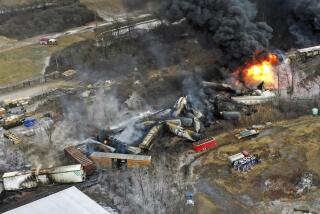Nuclear plant safety improves despite lapses, watchdog group says
U.S. commercial nuclear power plants had 10 serious incidents in 2013 that could have resulted in damage to nuclear reactors, but the industry’s overall safety record improved, the Union of Concerned Scientists said Friday.
The Washington-based watchdog group cited several incidents in its 60-page annual report, showing inconsistent safety enforcement by the Nuclear Regulatory Commission and lapses at the nation’s commercial reactors.
David Lochbaum, a nuclear engineer who leads the union’s nuclear safety project, says both the number of safety incidents and their severity declined last year. But he says it’s too early to say whether the reduction is part of a trend.
The report compiles and expands on incident reports that the regulatory agency collected in 2013, including the failure of a temporary crane at Entergy Corp.’s Arkansas Nuclear One plant. A heavy part from a generator dropped through a floor, killing one worker and injuring eight others. Debris damaged nearby electrical equipment, which caused one of the plant reactors operating at full power to trip offline.
[Updated, 1:48 p.m. March 7: NRC spokesman Victor Dricks said in an email to The Times that the damage caused by the crane accident at the plant’s unit one reactor cut off outside power for six days, forcing it to rely on emergency diesel generators. “This condition increased risk to the plant because alternate means of providing electrical power to key safety related systems was not available in the event the diesels failed,” he said.]
Other incidents included two possible tampering cases that were part of a security investigation, neglected cracks in cooling tubes that required a reactor to be taken offline, and human error that caused a reactor to trip when its coolant levels dropped.
The union calls the incidents “near misses” that in some cases could have resulted in damage to the nuclear cores or meltdowns at plants. The Nuclear Regulatory Commission calls those incidents by a somewhat more benign term: “accident sequence precursor.”
Lochbaum said it was “inexcusable” that plant owners consistently overlooked potentially serious safety problems.
The Nuclear Energy Institute, the trade group that represents nuclear utilities, took strong exception to the report, saying it was based on a “bogus arbitrary threshold that does not correlate to safety performance.”
“Our facilities are operating at high levels of safety,” institute spokesman Steven Kerekes said.
Kerekes said no more than a few safety incidents had occurred at plants in the last decade, asserting that the union’s figures were inflated.
Lochbaum has worked at nuclear power plants and says he does not consider himself an opponent of the technology. The regulatory agency is generally doing a better of job of overseeing the industry, he says, but has failed to consistently carry through with necessary safety upgrades.
Lochbaum pointed to the Diablo Canyon nuclear plant on the California coast near San Luis Obispo as the nation’s second-riskiest plant, noting that an undersea fault could cause ground motion that would exceed what the plant was designed to handle. Upgrades could fix the problem, he added.
Pacific Gas & Electric, the plant owner, contends that Nuclear Regulatory Commission analysis shows the plant has adequate safety margins.
Duke Energy’s Oconee Nuclear Station in South Carolina would rank as the nation’s riskiest plant, vulnerable to failure of the nearby Jocassee Dam that would send a 14-foot flood and disable the plant’s cooling systems. Duke asserts that the plant has provided power safely and reliably for 40 years, and that the risk of a dam failure is minuscule.
“The NRC knows that Diablo Canyon and Oconee are flouting its safety standards, and it’s letting them get away with it,” Lochbaum said.
During 2013, four of the nation’s commercial reactors were taken out of service, including two at Southern California Edison’s San Onofre plant. Three of the four units were taken out because of technical problems that were too costly to fix, and one plant stopped operating when it became uncompetitive with conventional plants, Lochbaum said.
On the other hand, the Nuclear Energy Institute notes that five new reactors are under construction in Georgia, South Carolina and Tennessee.
“We expect to see more reactors now in preliminary planning be ordered formally toward end of decade,” Kerekes said. “We need electricity demand to pick back up from recession, for one. [It’s] still below 2007 levels.”
Lochbaum says he doesn’t know whether new construction will exceed the decomissioning of old reactors, leaving it unclear whether the industry will expand or shrink.
“It is hard to tell what is the more dominant trend,” he said.
[For the record, 1:48 p.m. March 7: An earlier version of this post misspelled David Lochbaum’s name as Lockbaum.]
Follow LA Times National on Facebook
More to Read
Sign up for Essential California
The most important California stories and recommendations in your inbox every morning.
You may occasionally receive promotional content from the Los Angeles Times.











